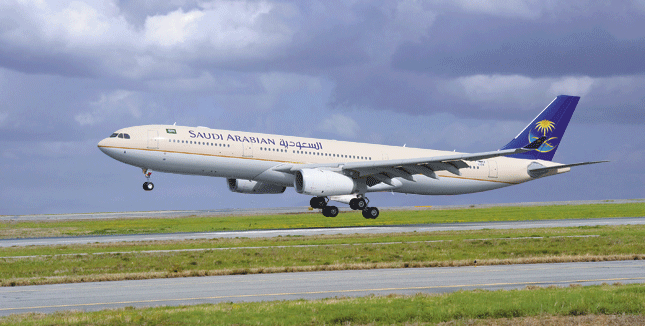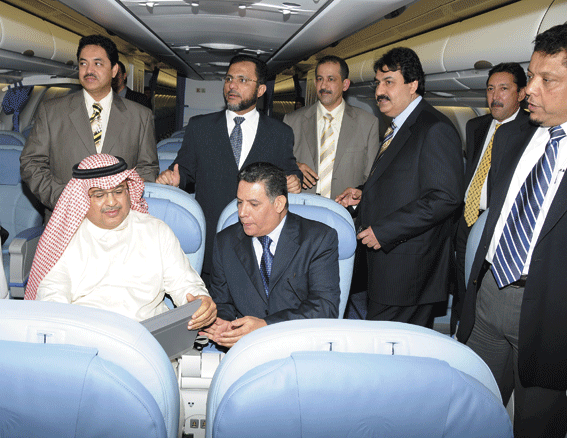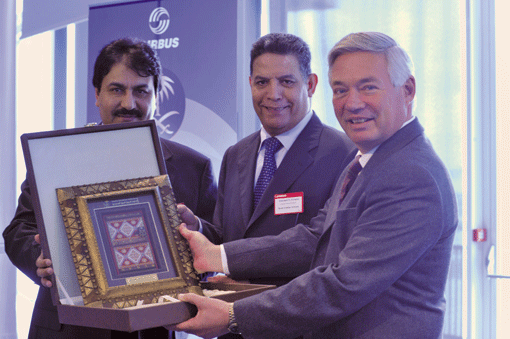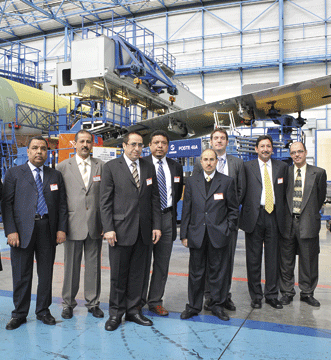

Saudi Arabian
Receives Advanced
A330 Aircraft
 |
Saudi Arabian Airlines received its first long range
Airbus aircraft A330, which is equipped with advanced communication and entertainment systems, on Monday (May 17, 2010).
Director General Mr. Khaled Al-Molhem and other top Saudi Arabian and aviation officials
were present
at King Abdulaziz International Airport in Jeddah
to receive the aircraft.
“We are delighted to receive the first of eight A300 - 330 aircraft that we have ordered at a time when passenger demand is rising,” Al-Molhem told reporters. He disclosed Saudi Arabian Airlines’ plan to purchase more advanced aircraft in the coming years to strengthen its fleet, confront competition and operate flights to new destinations.
The national carrier will operate A330s on domestic and international routes as and when the carrier takes delivery of the remaining aircraft in the family. “With unbeatable economics and passenger comfort, the A330 is the ideal aircraft for us. Together with our new Airbus A320s, our A330s will allow us to get the maximum efficiency from flying two aircraft families which share common controls and maintenance,” Al-Molhem said.
The Rolls Royce-powered A330-300 is the first to be delivered from an order for eight aircraft signed in July 2008. The new aircraft has 36 seats for Business Class and 262 seats for Guest Class. It was formally delivered during a ceremony in the French city of Toulouse, which was attended by Mr. Abdulaziz Al-Hazmi, Deputy Director General of the Airline, and Airbus’ Chief Operating Officer John Leahy.
“It is a remarkable achievement that the Airbus A330 has become essential to Saudi Arabian Airlines’ fleet modernization. The A330 is today’s leading medium- to long-range twin aisle aircraft, with market leading productivity and proven reliability. The aircraft will also meet the most demanding passenger comfort expectations,” Leahy said.
Addressing the ceremony DDG Al-Hazmi expressed his happiness over Saudi Arabian receiving the most advanced A330 aircraft that would strengthen the Airline’s fleet and provide greater facilities to its passengers. He underscored the cooperation between Saudi Arabian Airlines and Airbus. He also thanked the Saudi leadership for its generous support to the national carrier. Speaking to reporters on board the newly purchased A300 - 330 aircraft, Al-Molhem said Saudia would carry out its fleet modernization program in accordance with its requirements.
He said Saudi Arabian would receive all of the 70 new Airbus and Boeing aircraft by the end of 2014. The DG said the new planes would enable the Middle East’s largest airliner to provide better services to its passengers. “We intend to modernize our fleet by purchasing the most advanced planes available in the world,” he said.
Privatization Program
He also spoke about the airline’s prestigious privatization program, which has made tremendous progress over the past years. “We have been implementing this program in a scientific manner, making use of the experiences of leading airline companies in the world. It will not only help Saudi Arabian achieve its strategic goals but also strengthen the Kingdom’s air transport industry.” Saudi Arabian Airlines has already privatized its catering and cargo sectors. “We’ll complete privatization of the maintenance and ground service sectors this year,” the Saudi Arabian chief said. “We are also working on privatizing the core aviation unit,” he added. Saudi Airlines successfully migrated to Amadeus, an advanced passenger management system, recently. “The system is now operating perfectly. Our customers can now feel a big difference in services. Passengers will be able to complete all travel procedures by themselves without approaching a travel agent,” he said. The migration marks a major milestone for Saudi Arabian Airlines. During cutover 3.2million tickets, 1.3million Passenger Name Records (PNRs) and 1.3million frequent flyer profiles were moved to the new system. The Amadeus Reservation Desktop application was installed on over 3,000 PCs at over 500 office locations worldwide and over 3,800 employees were trained on the new applications and processes.
11 New Planes Received
According to Abdullah Al-Ajhar, VP Public Relations, Saudi Arabian has so far received 11 of the 70 planes it has ordered. “We have signed an agreement with OnAir to provide Internet and cell phone services to passengers abroad our A330 aircraft,” he said, adding that aircraft crew can control the service. 
“Cell phone will be operating with minimum power without affecting aviation control and security systems,” he added. However, he pointed out that passengers should have roaming facility from their mobile service providers in order to benefit from the service. Spelling out other features of the new aircraft, Mr. Al-Ajhar said it has a special prayer area, places to keep two medical beds, and facilities to operate all types of medical equipment with the support of electricity. “It is also provided with a toilet for people of special needs,” he said.
The Airbus A330 remains the most economic means of flying some 300 passengers on medium range routes in true long haul comfort. Offering unbeatable operating economics and productivity, the A330 is also one of the world’s most fuel-efficient aircraft.
Saudi Airlines has ordered 58 Airbus aircraft with advanced facilities, including A320s, A321s and A330s. With over 1000 sales, the popularity of the A330 family is growing rapidly because of its ability to serve more markets with greater efficiently than other aircraft. “The A330 is a highly successful family of true wide-body aircraft models that respond to many specific airline needs covering 200 to 400 seat, regional to long haul passenger markets and the 64 - 69 ton cargo market,” Airbus said in a statement. The delivery takes the number of customers and operators of the world’s most popular twin aisle medium- to long-haul aircraft to 140.
The company has already sold more than 600 A330s to 81 operators in 40 countries and has received over 1,030 new orders for the same model. About 300 airports worldwide are currently served by A330s. “One A330 takes off every 62 seconds,” the statement said, adding that A330s have so far carried more than 700 million passengers.
Comfortably carrying 253 passengers in a three-class arrangement, the A330-200 was developed from the larger A330-300 and entered into service in 1998. Its 13,300km/7200nm range enables it to efficiently serve destinations like Tokyo from the US West Coast, or short hops such as Dubai to Muscat. “The A330 cabin is quieter than other large twinjet aircraft,” the company said. The A330 can be equipped with the latest in-flight entertainment systems and the new generation of on-board communications, allowing passengers and crew to be as well connected in the air as on the ground. The spaciousness of the A330 cabin is matched by the capacity of its under-floor cargo holds.